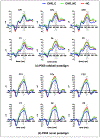P300 as an index of transition to psychosis and of remission: Data from a clinical high risk for psychosis study and review of literature
- PMID: 30819593
- PMCID: PMC6708777
- DOI: 10.1016/j.schres.2019.02.014
P300 as an index of transition to psychosis and of remission: Data from a clinical high risk for psychosis study and review of literature
Abstract
Auditory P300 oddball and novel components index working memory operations and salience processing, respectively, and are regarded as biomarkers of neurocognitive changes in both chronic and first-episode schizophrenia. Much less is known about whether P300 abnormalities exist in individuals at clinical high risk for psychosis (CHR) and if they are predictors of both transition to psychosis and remission from symptoms. One hundred and four CHR and 69 healthy control individuals (HC) completed P300 oddball paradigm, and 131 CHR and 69 HC subjects completed P300 novel paradigm. All CHR subjects were followed up for one year and stratified into CHR converters (CHRC) and non-converters (CHR-NC), with CHR-NC further stratified into remitted and non-remitted subgroups. Between-group comparisons of P300 oddball and novel amplitude and latency were performed among CHRC, CHR-NC and HC, as well as among CHRC, non-remitted CHR, remitted CHR and HC. CHR converters had lower fronto-central P300 novel amplitude as well as marginally lower P300 oddball amplitude relative to HC. When CHR non-converters were stratified into remitted and non-remitted subgroups, P300 novel amplitude in remitted CHR subjects was comparable to HC, and it was higher than that in CHR subjects who converted to psychosis or who did not remit. Thus, reduced P300 novel amplitude indexing impaired salience processing marked both conversion to psychosis and remission from psychotic symptoms.
Keywords: Clinical high risk for psychosis; P300 novel; P300 oddball; Remission from psychotic symptoms; Transition to psychosis.
Copyright © 2019 Elsevier B.V. All rights reserved.
Conflict of interest statement
Conflict of Interest
None.
Figures



Similar articles
-
Auditory and visual oddball stimulus processing deficits in clinical high risk for psychosis: Forecasting psychosis risk with N200 and P300.Prog Neuropsychopharmacol Biol Psychiatry. 2025 Jul 13;140:111426. doi: 10.1016/j.pnpbp.2025.111426. Epub 2025 Jun 11. Prog Neuropsychopharmacol Biol Psychiatry. 2025. PMID: 40513806
-
Auditory N100 amplitude deficits predict conversion to psychosis in the North American Prodrome Longitudinal Study (NAPLS-2) cohort.Schizophr Res. 2022 Oct;248:89-97. doi: 10.1016/j.schres.2022.07.019. Epub 2022 Aug 19. Schizophr Res. 2022. PMID: 35994912 Free PMC article.
-
Longitudinal evaluation of visual P300 amplitude in clinical high-risk subjects: An event-related potential study.Psychiatry Clin Neurosci. 2020 Oct;74(10):527-534. doi: 10.1111/pcn.13083. Epub 2020 Jul 20. Psychiatry Clin Neurosci. 2020. PMID: 32519778
-
Forecasting Remission From the Psychosis Risk Syndrome With Mismatch Negativity and P300: Potentials and Pitfalls.Biol Psychiatry Cogn Neurosci Neuroimaging. 2021 Feb;6(2):178-187. doi: 10.1016/j.bpsc.2020.10.010. Epub 2020 Oct 24. Biol Psychiatry Cogn Neurosci Neuroimaging. 2021. PMID: 33431345 Free PMC article. Review.
-
Neurocognition in clinical high risk young adults who did or did not convert to a first schizophrenic psychosis: a meta-analysis.Schizophr Res. 2013 Sep;149(1-3):48-55. doi: 10.1016/j.schres.2013.06.017. Epub 2013 Jul 5. Schizophr Res. 2013. PMID: 23830855 Review.
Cited by
-
Biomarkers for Psychosis: Are We There Yet? Umbrella Review of 1478 Biomarkers.Schizophr Bull Open. 2024 Aug 30;5(1):sgae018. doi: 10.1093/schizbullopen/sgae018. eCollection 2024 Jan. Schizophr Bull Open. 2024. PMID: 39228676 Free PMC article.
-
Neural Circuitry of Salience and Reward Processing in Psychosis.Biol Psychiatry Glob Open Sci. 2021 Dec 11;3(1):33-46. doi: 10.1016/j.bpsgos.2021.12.003. eCollection 2023 Jan. Biol Psychiatry Glob Open Sci. 2021. PMID: 36712572 Free PMC article. Review.
-
Electroencephalography and Event-Related Potential Biomarkers in Individuals at Clinical High Risk for Psychosis.Biol Psychiatry. 2020 Aug 15;88(4):294-303. doi: 10.1016/j.biopsych.2020.04.002. Epub 2020 Apr 14. Biol Psychiatry. 2020. PMID: 32507388 Free PMC article. Review.
-
Comprehensive review of multidimensional biomarkers in the ShangHai At Risk for Psychosis (SHARP) program for early psychosis identification.PCN Rep. 2023 Nov 14;2(4):e152. doi: 10.1002/pcn5.152. eCollection 2023 Dec. PCN Rep. 2023. PMID: 38868725 Free PMC article. Review.
-
P300 in schizophrenia: Then and now.Biol Psychol. 2024 Mar;187:108757. doi: 10.1016/j.biopsycho.2024.108757. Epub 2024 Feb 3. Biol Psychol. 2024. PMID: 38316196 Free PMC article. Review.
References
-
- Atkinson RJ, Michie PT, Schall U, 2012. Duration mismatch negativity and P3a in first-episode psychosis and individuals at ultra-high risk of psychosis. Biol. Psychiatry 71(2), 98–104. - PubMed
-
- Bramon E, Shaikh M, Broome M, Lappin J, Berge D, Day F, Woolley J, Tabraham P, Madre M, Johns L, Howes O, Valmaggia L, Perez V, Sham P, Murray RM, McGuire P, 2008. Abnormal P300 in people with high risk of developing psychosis. Neuroimage 41(2), 553–560. - PubMed
-
- Cannon TD, Chung Y, He G, Sun DQ, Jacobson A, van Erp TGM, McEwen S, Addington J, Bearden CE, Cadenhead K, Cornblatt B, Mathalon DH, McGlashan T, Perkins D, Jeffries C, Seidman LJ, Tsuang M, Walker E, Woods SW, Heinssen R, S, N.A.P.L., 2015. Progressive reduction in cortical thickness as psychosis develops: A multisite longitudinal neuroimaging study of youth at elevated clinical risk. Biol. Psychiatry 77(2), 147–157. - PMC - PubMed
Publication types
MeSH terms
Grants and funding
LinkOut - more resources
Full Text Sources
Medical
Miscellaneous

